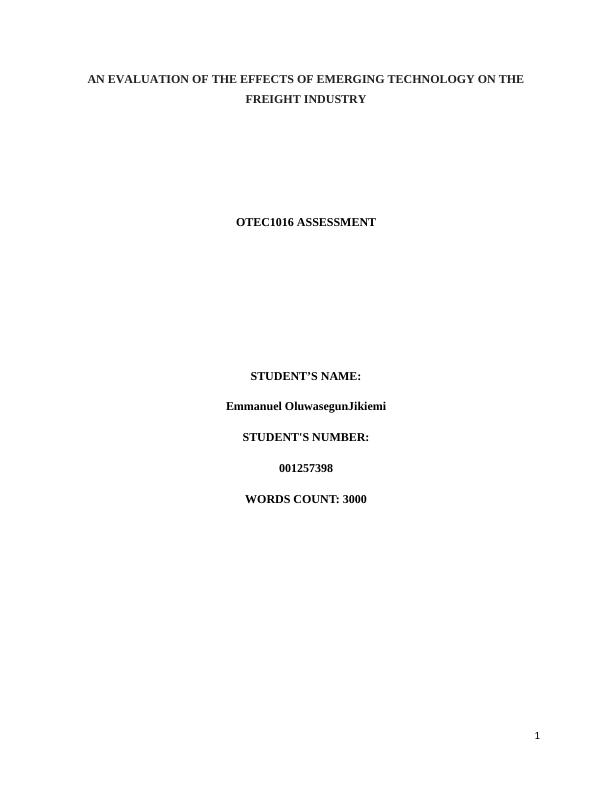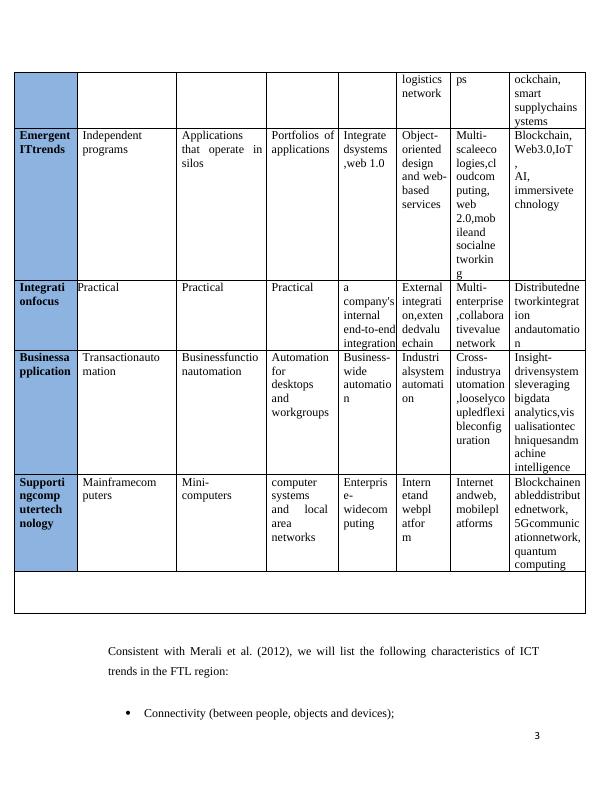Effects of Emerging Technology on the Freight Industry
Added on 2023-02-07
15 Pages3753 Words31 Views
AN EVALUATION OF THE EFFECTS OF EMERGING TECHNOLOGY ON THE
FREIGHT INDUSTRY
OTEC1016 ASSESSMENT
STUDENT’S NAME:
Emmanuel OluwasegunJikiemi
STUDENT'S NUMBER:
001257398
WORDS COUNT: 3000
1
FREIGHT INDUSTRY
OTEC1016 ASSESSMENT
STUDENT’S NAME:
Emmanuel OluwasegunJikiemi
STUDENT'S NUMBER:
001257398
WORDS COUNT: 3000
1

1.1 INTRODUCTION
A paradigm shift in the transportation industry is currently taking place, which corresponds to
changes in energy use, digital technologies and behavioral patterns. These developments have an
impact on how the logistics and freight sectors of the economy operate. To profit from the
opportunities and advantages that this shift brings, it must be thoroughly understood.The study
discusses the possibilities offered by newly developed digital technologies for supply chain
management. We eagerly await the outcome of today's decision. The review uses a wide range of
academic and practical material. The UK government has been given advice on how to use
digital freight to its advantage and improve the country's global competitiveness.Below is a
summary of the report. Section 2 summarizes major technological developments in freight
transport. A brief history of freight digitization is first reviewed, followed by an extensive
description of current systems. The report centers on the initial situation of technology landscape
in the freight industry. In future to come, some technologies may evolve to a higher level, while
others may not.The recommendations in the final paragraphs of Section 3 address industry
sustainability and highlight four key areas where the government should focus on improving the
UK's international competitiveness. A summary of how technology is impacting the freight
business can be found in the last section.
2.0 The Impacts of Emerging Technologies on The Freight Sector
2.1 The Evolution of Digital Developments
The transportation industry is undergoing a paradigm shift due to changes in energy use,
digital technologies and behavioral patterns. They begin to experience these changes.
Table 1 summarizes the historical progression of FTL digitization from the 1960s to the
future.
Typical
FTLsyste
ms
Inventory control,
accounts
receivable, and
management
Transportplanni
ngapplication,
MRPI
TMS,
WMS,MRPI
I
ERP,
DSSCR
M
ERPII,
internet-
based
ELMor
e-
Internet-
basedco
mmunity
systems,
mobileap
Industry-
wideIoT
platform,pri
vate
andpublicbl
2
A paradigm shift in the transportation industry is currently taking place, which corresponds to
changes in energy use, digital technologies and behavioral patterns. These developments have an
impact on how the logistics and freight sectors of the economy operate. To profit from the
opportunities and advantages that this shift brings, it must be thoroughly understood.The study
discusses the possibilities offered by newly developed digital technologies for supply chain
management. We eagerly await the outcome of today's decision. The review uses a wide range of
academic and practical material. The UK government has been given advice on how to use
digital freight to its advantage and improve the country's global competitiveness.Below is a
summary of the report. Section 2 summarizes major technological developments in freight
transport. A brief history of freight digitization is first reviewed, followed by an extensive
description of current systems. The report centers on the initial situation of technology landscape
in the freight industry. In future to come, some technologies may evolve to a higher level, while
others may not.The recommendations in the final paragraphs of Section 3 address industry
sustainability and highlight four key areas where the government should focus on improving the
UK's international competitiveness. A summary of how technology is impacting the freight
business can be found in the last section.
2.0 The Impacts of Emerging Technologies on The Freight Sector
2.1 The Evolution of Digital Developments
The transportation industry is undergoing a paradigm shift due to changes in energy use,
digital technologies and behavioral patterns. They begin to experience these changes.
Table 1 summarizes the historical progression of FTL digitization from the 1960s to the
future.
Typical
FTLsyste
ms
Inventory control,
accounts
receivable, and
management
Transportplanni
ngapplication,
MRPI
TMS,
WMS,MRPI
I
ERP,
DSSCR
M
ERPII,
internet-
based
ELMor
e-
Internet-
basedco
mmunity
systems,
mobileap
Industry-
wideIoT
platform,pri
vate
andpublicbl
2

logistics
network
ps ockchain,
smart
supplychains
ystems
Emergent
ITtrends
Independent
programs
Applications
that operate in
silos
Portfolios of
applications
Integrate
dsystems
,web 1.0
Object-
oriented
design
and web-
based
services
Multi-
scaleeco
logies,cl
oudcom
puting,
web
2.0,mob
ileand
socialne
tworkin
g
Blockchain,
Web3.0,IoT
,
AI,
immersivete
chnology
Integrati
onfocus
Practical Practical Practical a
company's
internal
end-to-end
integration
External
integrati
on,exten
dedvalu
echain
Multi-
enterprise
,collabora
tivevalue
network
Distributedne
tworkintegrat
ion
andautomatio
n
Businessa
pplication
Transactionauto
mation
Businessfunctio
nautomation
Automation
for
desktops
and
workgroups
Business-
wide
automatio
n
Industri
alsystem
automati
on
Cross-
industrya
utomation
,looselyco
upledflexi
bleconfig
uration
Insight-
drivensystem
sleveraging
bigdata
analytics,vis
ualisationtec
hniquesandm
achine
intelligence
Supporti
ngcomp
utertech
nology
Mainframecom
puters
Mini-
computers
computer
systems
and local
area
networks
Enterpris
e-
widecom
puting
Intern
etand
webpl
atfor
m
Internet
andweb,
mobilepl
atforms
Blockchainen
ableddistribut
ednetwork,
5Gcommunic
ationnetwork,
quantum
computing
Consistent with Merali et al. (2012), we will list the following characteristics of ICT
trends in the FTL region:
Connectivity (between people, objects and devices);
3
network
ps ockchain,
smart
supplychains
ystems
Emergent
ITtrends
Independent
programs
Applications
that operate in
silos
Portfolios of
applications
Integrate
dsystems
,web 1.0
Object-
oriented
design
and web-
based
services
Multi-
scaleeco
logies,cl
oudcom
puting,
web
2.0,mob
ileand
socialne
tworkin
g
Blockchain,
Web3.0,IoT
,
AI,
immersivete
chnology
Integrati
onfocus
Practical Practical Practical a
company's
internal
end-to-end
integration
External
integrati
on,exten
dedvalu
echain
Multi-
enterprise
,collabora
tivevalue
network
Distributedne
tworkintegrat
ion
andautomatio
n
Businessa
pplication
Transactionauto
mation
Businessfunctio
nautomation
Automation
for
desktops
and
workgroups
Business-
wide
automatio
n
Industri
alsystem
automati
on
Cross-
industrya
utomation
,looselyco
upledflexi
bleconfig
uration
Insight-
drivensystem
sleveraging
bigdata
analytics,vis
ualisationtec
hniquesandm
achine
intelligence
Supporti
ngcomp
utertech
nology
Mainframecom
puters
Mini-
computers
computer
systems
and local
area
networks
Enterpris
e-
widecom
puting
Intern
etand
webpl
atfor
m
Internet
andweb,
mobilepl
atforms
Blockchainen
ableddistribut
ednetwork,
5Gcommunic
ationnetwork,
quantum
computing
Consistent with Merali et al. (2012), we will list the following characteristics of ICT
trends in the FTL region:
Connectivity (between people, objects and devices);
3

Data and processing power of garage storage rooms;
Quantity and type of information sent; Information transmission speed (rate and
quantity).
When we photographed contemporary FTL virtual structures, we found that many heterogeneous
structures coexisted and communicated with each other. Depending on the situation, there may
be varying degrees of interdependence and interconnection. As digital connections between
businesses and their supply chain partners must take many forms, current technological
advancements have made virtual connections more flexible and affordable, but they also create
problems for businesses. The open nature of complex buildings makes effective ICT deployment
difficult and challenging. The development of various software programs and standards is
fragmented, there are interoperability issues between different structures, technical expertise is
lost, and implementation time and cost are all issues. Emerging technologies are becoming
increasingly difficult due to expanding ethical, safety, environmental and legal challenges. The
ability to manage the mix of ICT structures is essential to ensure the steady flow of statistics and
substances in the supply chain. To ensure that FTL regions remain motivated, these difficult
situations require effective coverage interventions and infrastructure enhancements.
2.2 Major Technological Trends
Seven generations of innovation are expected to have an impact on the UK's freight industry.
Like others, some technologies which includes the IoT and the cloud computing have made
progress, while others are still in their infancy. For the industry, these present both possibility
and disruption.
Cloud computing
A cloud-based, entirely online logistics market is a typical illustration of cloud computing in a
multimodal shipping context (ELM). ELMs are entirely ICT-based web-based structures that
give shippers, businesses, and customers linkages for carriers to use in spot trading.
Compared to other technologies, the era of cloud computing in freight may be the most
advanced. Cost-effectiveness is the most frequently mentioned advantage of cloud computing,
4
Quantity and type of information sent; Information transmission speed (rate and
quantity).
When we photographed contemporary FTL virtual structures, we found that many heterogeneous
structures coexisted and communicated with each other. Depending on the situation, there may
be varying degrees of interdependence and interconnection. As digital connections between
businesses and their supply chain partners must take many forms, current technological
advancements have made virtual connections more flexible and affordable, but they also create
problems for businesses. The open nature of complex buildings makes effective ICT deployment
difficult and challenging. The development of various software programs and standards is
fragmented, there are interoperability issues between different structures, technical expertise is
lost, and implementation time and cost are all issues. Emerging technologies are becoming
increasingly difficult due to expanding ethical, safety, environmental and legal challenges. The
ability to manage the mix of ICT structures is essential to ensure the steady flow of statistics and
substances in the supply chain. To ensure that FTL regions remain motivated, these difficult
situations require effective coverage interventions and infrastructure enhancements.
2.2 Major Technological Trends
Seven generations of innovation are expected to have an impact on the UK's freight industry.
Like others, some technologies which includes the IoT and the cloud computing have made
progress, while others are still in their infancy. For the industry, these present both possibility
and disruption.
Cloud computing
A cloud-based, entirely online logistics market is a typical illustration of cloud computing in a
multimodal shipping context (ELM). ELMs are entirely ICT-based web-based structures that
give shippers, businesses, and customers linkages for carriers to use in spot trading.
Compared to other technologies, the era of cloud computing in freight may be the most
advanced. Cost-effectiveness is the most frequently mentioned advantage of cloud computing,
4

End of preview
Want to access all the pages? Upload your documents or become a member.
Related Documents
Lean Six Sigma Assignment 2022lg...
|6
|993
|29
Business Research Methods: Task 1lg...
|11
|2785
|91
Increased Use of A.I. and Robotics in Manufacturing and Tourism Industrieslg...
|10
|3364
|77
CLBE 304 Assesment-3 Cloud Computing - 11 Weeks Content Analysislg...
|11
|3657
|108
